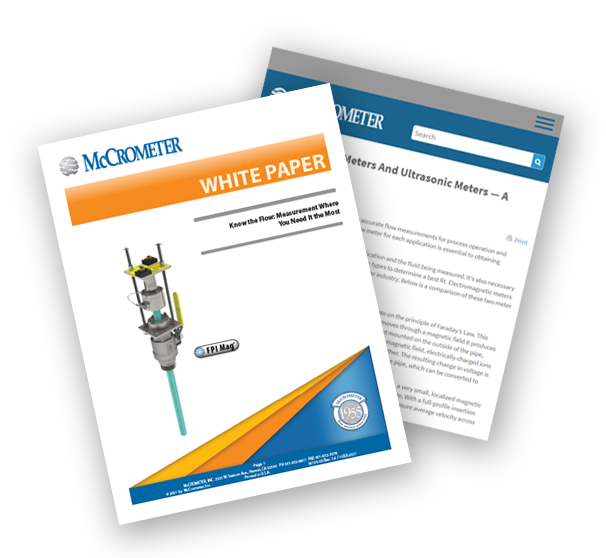- PRODUCTS
- INDUSTRIES
- RESOURCES
- SUPPORT
Electromagnetic flow meters (also called mag meters or magnetic meters), are volumetric flow meters which do not have any moving parts to wear, reducing the need for maintenance or replacement. Our mag meters have an accuracy over a wide flow range can be as good as ± 0.5% of flow rate or better.
McCrometer has over 70 years’ experience in flow measurement and is a global leader in electromagnetic flow meters. We are committed to innovative solutions and the highest possible quality in flow instrumentation. We offer a range of full bore and insertion-style electromagnetic meters - suitable for agriculture, municipal, industrial, and even oil and gas applications. Mag meters are commonly used for water-based liquids, but some models can also measure mixed media like slurries and sludge.
Mag meters operate under the principle of Faraday’s Law of Electromagnetic Induction to measure liquid velocity. The principle of operation states that a conductor moving through a magnetic field produces an electric signal within the conductor, which is directly proportional to the velocity of the water moving through the field.
As fluid flows through the magnetic field, conductive particles in the fluid create changes in voltage across the magnetic field. This variation is used to measure and calculate the velocity of water flow through the pipe.
Our goal is to be our customers’ advisor and partner from project inception to ongoing metering champion.
McCrometer’s unique saddle mount mag meters provide all the benefits of mag meters with the simplest possible installation. These flow meters have been especially designed for agricultural use cases.
The McMag 2000 retrofits using the Mc®Propeller saddle and offers Pulse output for system integration. Offering a 5-year full warranty, easy installation, and in-field maintenance, the McMag 2000 is the only mag meter on the market that maintains accuracy with flow straighteners!
The McMag 3000 mag meter features robust construction and an angled sensor that sheds debris, making it ideal for use in surface water, dairy lagoons, and other dirty water applications.
Designed for the specific needs of the industrial, water, and wastewater industries, flanged flow meters also have wafer style configurations to meet installation specifications.
Requiring only 2D upstream and 1D downstream straight-run, the Dura Mag offers a 5-year meter and battery warranty, and lifetime liner guarantee. Its fusion-bonded epoxy coating eliminates risk of liner separation and water intrusion.
Our specialists and customer service team members are happy to answer any questions you may have. In the meantime, here are a few we answer a lot.
Magnetic flow meters can work in almost any water-based use case, but they provide special value in a few specific industries: Magnetic flow meters can work in almost any water-based use case, but they provide special value in a few specific industries, especially in Agriculture. Mag meters are a favorite in this industry as they support irrigation projects; the fact that they include no moving parts means they work reliably in the field with no oversight or preventive maintenance needed.
Depending upon the product, it may vary. Our Ultra Mag and our FPI Mag offer up to ±0.5%. Our Dura Mag offers up to ±1%, and our SPI Mag, McMag 3000 and McMag 2000 offer up to ±2%. With extra calibration, the McMag 3000 can provide up to ±1% accuracy.
Electromagnetic flow meters are generally resistant to debris due to their design. They can handle suspended solids or debris if the particles do not obstruct the flow sensor electrodes. Larger particles or excessive debris can potentially interfere with the measurement accuracy, necessitating periodic maintenance to ensure optimal performance in challenging environments. Read further in our blog post about deciding which differential pressure meter type is right for you.
Although the names may be similar, each mag meter has a unique construction and design, as well as different product specs and value-rich features that different customers favor. While the McMag3000 is slightly more accurate, the McMag2000 offers convenience and is DIY retrofit-capable for customers wanting to make the change from the saddle-style McPropeller to a “no moving parts” meter.
It’s easy to see why mag meters are a lot of engineers’ favorite flow meters, but they’re not perfect for every setting. Electromagnetic meters are best suited for fluids with a conductivity that is 20 ohm/cm or higher. That means they’re not the best for low-velocity applications such as petroleum-based fluids.
Looking for more information or details on our products? Feel free to fill out the form below and our team will reach out soon.

Check out further information about oil, gas, and coal applications.
Technical article
FPI Mag white paper
Blog article
© Copyright McCrometer, Inc. | 3255 West Stetson Avenue, Hemet, CA 92545 USA | +1-800-220-2279 | Fax +1-951-652-3078 | HR secure fax (866) 753-7459
To view the Partnership Homepage, select "Your Account" in the top right corner, and choose "Partnership Home"

